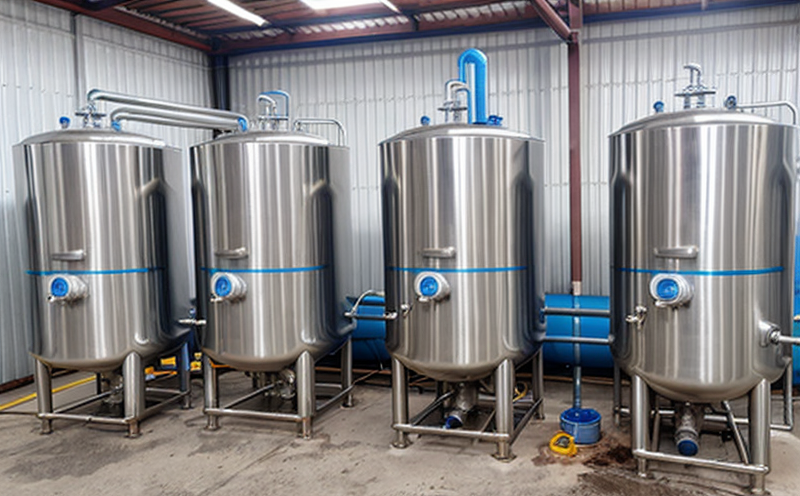ASTM D1976 Zinc Test in Cooling Water
The ASTM D1976 test method is specifically designed to determine the concentration of zinc in water samples. This test is particularly relevant for industries that rely heavily on cooling systems, such as power generation, manufacturing, and petrochemical plants. The presence of zinc can have significant implications for the longevity and efficiency of these critical systems.
The ASTM D1976 method involves a series of steps to ensure accurate measurement, including sample collection, preparation, and analysis using atomic absorption spectroscopy (AAS). This technique allows for precise quantification of zinc at low concentrations. The test is vital for quality managers and compliance officers who need to monitor the integrity of their cooling water systems.
The methodology ensures that all samples are handled under controlled conditions to minimize contamination. Proper sample preparation is crucial, as even minor impurities can skew results. Once prepared, the samples undergo analysis via AAS, which provides accurate readings within a wide range of concentrations.
Understanding the role of zinc in cooling water systems is essential for R&D engineers and procurement specialists. Zinc plays several critical roles in these systems:
- Corrosion Inhibition: Zinc acts as an effective corrosion inhibitor, protecting metal components from degradation.
- Prestressing: It helps maintain the structural integrity of materials used in cooling towers and boilers.
- Biocide Activation: Zinc enhances the effectiveness of biocides, which are essential for preventing biofilm formation.
The test results provide critical data that can inform decisions on maintenance schedules and chemical treatments. By monitoring zinc levels regularly, facilities can optimize their water treatment processes to extend equipment lifespan and reduce operational costs.
In summary, the ASTM D1976 test is an indispensable tool for maintaining high standards of water quality in cooling systems. It ensures compliance with industry regulations and helps prevent costly downtime due to system failures.
Scope and Methodology
The scope of the ASTM D1976 method includes the determination of zinc in various types of water used in industrial applications, particularly cooling systems. This test is applicable to both open-loop and closed-loop systems where zinc plays a crucial role.
The methodology involves several key steps:
- Sample Collection: Samples are collected from the cooling system at specified intervals. Proper collection ensures that the sample accurately represents the conditions of the water in question.
- Preparation: The samples are prepared according to ASTM D1976 guidelines, which may include dilution or concentration steps as necessary.
- Analysis: Atomic absorption spectroscopy (AAS) is used for precise measurement of zinc content. This technique provides high sensitivity and selectivity, making it ideal for this application.
The results are reported in parts per million (ppm), providing a clear indication of the zinc concentration in the water sample. Compliance with industry standards such as ASTM D1976 is essential to ensure accurate and reliable testing.
For facilities that use cooling systems, regular testing is crucial for maintaining optimal performance. The test results can help identify potential issues early, allowing for timely interventions and preventing costly repairs.
Quality and Reliability Assurance
- Standard Operating Procedures: Strict adherence to ASTM D1976 ensures consistent and reliable testing results. Standard operating procedures (SOPs) are in place to guide every step of the process, from sample collection to final analysis.
- Safety Measures: Safety is paramount during all stages of the test. Personal protective equipment (PPE) is provided, and all personnel undergo regular training on safe handling practices.
- Instrument Calibration: All instrumentation used in the testing process is regularly calibrated to ensure accuracy and precision.
The reliability of ASTM D1976 zinc tests is further enhanced through rigorous quality control measures. These include internal audits, external validation, and participation in proficiency testing programs. Such programs provide an independent assessment of the laboratory's analytical capabilities, ensuring that results are accurate and reliable.
Regular calibration and maintenance of equipment ensure that all instruments perform optimally throughout their operational life. This proactive approach to quality control helps maintain high standards of accuracy and precision in every test conducted.
International Acceptance and Recognition
- ISO 17025: The laboratory adheres to the ISO 17025 accreditation, which sets international standards for competence in testing and calibration laboratories. This certification ensures that all tests conducted meet the highest quality standards.
- American National Standards Institute (ANSI): Compliance with ANSI standards further reinforces the reliability of the ASTM D1976 zinc test results.
The ASTM D1976 method is widely recognized and accepted across various sectors, including power generation, manufacturing, and petrochemicals. Its international acceptance ensures that the test results are valid and comparable worldwide.
Participation in proficiency testing programs organized by organizations such as the International Laboratory Accreditation Cooperation (ILAC) and the National Institute of Standards and Technology (NIST) further validates the accuracy and reliability of the test results. These programs provide a benchmark against which the laboratory's performance is evaluated, ensuring consistent high standards.
The ASTM D1976 zinc test is an essential tool for maintaining water quality in industrial cooling systems. Its international recognition ensures that facilities can rely on accurate and precise testing results, contributing to overall operational efficiency and compliance with industry regulations.





